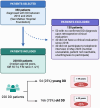Clinical outcomes of diverticular disease in young adults: results from a tertiary referral center
- PMID: 38646562
- PMCID: PMC11027500
- DOI: 10.3389/fmed.2024.1363548
Clinical outcomes of diverticular disease in young adults: results from a tertiary referral center
Abstract
Introduction: Diverticular disease (DD), commonly associated with the elderly, is becoming more prevalent among younger individuals. This retrospective study aimed to evaluate the differences in the natural history and outcomes between young and old patients with DD.
Methods: Adult patients with DD diagnosed between 2010 and 2022 at an Italian tertiary referral center were enrolled, and their demographic and clinical data were retrieved. The patients were categorized as young or old based on the 25th percentile of the population's age at diagnosis. Univariate and multivariate analyses were performed to assess the association between the collected variables and the age of disease presentation. Additionally, survival analyses were conducted to evaluate the association between the age of diagnosis and clinical outcomes at follow-up, including disease recurrence, hospital access, surgery, and death.
Results: A total of 220 DD patients (with a median age of 66 years, IQR 55-74, and a female-to-male ratio of 1.4:1) were included in the study, comprising 54 patients receiving a diagnosis before the age of 49 years (young DD patients) and 166 patients diagnosed after the age of 49 years (old DD patients). Male sex (57 vs. 36%, p < 0.01), smoking (38 vs. 14%, p < 0.01), and alcohol consumption (54 vs. 38%) were highly prevalent in young patients. The complications at the time of diagnosis, particularly abscesses and free perforations, occurred more frequently in younger patients (p = 0.04). Moreover, young DD patients experienced a higher rate of hospitalization and surgical intervention (p = 0.01 and p = 0.04, respectively) over a median follow-up period of 5 years.
Conclusion: Preventive strategies and prompt diagnosis are crucial in young patients with DD for achieving better disease outcomes and preventing complications.
Keywords: diverticula; hospitalization; outcome; prevention; recurrence; risk factor.
Copyright © 2024 Santacroce, Lenti, Abruzzese, Alunno, Di Terlizzi, Frenna, Gentile, Latorre, Petrucci, Ruggeri, Soriano, Aronico, De Silvestri, Corazza, Iacucci and Di Sabatino.
Conflict of interest statement
The authors declare that the research was conducted in the absence of any commercial or financial relationships that could be construed as a potential conflict of interest. The author(s) declared that they were an editorial board member of Frontiers, at the time of submission. This had no impact on the peer review process and the final decision.
Figures


References
LinkOut - more resources
Full Text Sources

